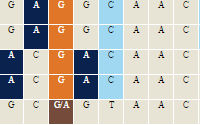
Gene-Chemical Interaction Annotations Click to see Annotation Detail View
Object Symbol | Species | Term | Qualifier | Evidence | With | Reference | Notes | Source | Original Reference(s) | Sppl3 | Rat | 1,2-dimethylhydrazine | decreases expression | ISO | Sppl3 (Mus musculus) | 6480464 | 1 and 2-Dimethylhydrazine results in decreased expression of SPPL3 mRNA | CTD | PMID:22206623 | Sppl3 | Rat | 2,3,7,8-tetrachlorodibenzodioxine | affects expression | ISO | Sppl3 (Mus musculus) | 6480464 | Tetrachlorodibenzodioxin affects the expression of SPPL3 mRNA | CTD | PMID:21570461 | Sppl3 | Rat | 2,3,7,8-tetrachlorodibenzodioxine | increases expression | EXP | | 6480464 | Tetrachlorodibenzodioxin results in increased expression of SPPL3 mRNA | CTD | PMID:34747641 | Sppl3 | Rat | 2,5-hexanedione | increases expression | EXP | | 6480464 | 2 and 5-hexanedione results in increased expression of SPPL3 mRNA | CTD | PMID:22952946 | Sppl3 | Rat | 3,4-methylenedioxymethamphetamine | increases expression | ISO | Sppl3 (Mus musculus) | 6480464 | N-Methyl-3 and 4-methylenedioxyamphetamine results in increased expression of SPPL3 mRNA | CTD | PMID:20188158 | Sppl3 | Rat | 3-isobutyl-1-methyl-7H-xanthine | multiple interactions | ISO | SPPL3 (Homo sapiens) | 6480464 | [INS protein co-treated with Dexamethasone co-treated with 1-Methyl-3-isobutylxanthine co-treated with Indomethacin co-treated with bisphenol F] results in decreased expression of SPPL3 mRNA | CTD | PMID:28628672 | Sppl3 | Rat | aristolochic acid A | decreases expression | ISO | SPPL3 (Homo sapiens) | 6480464 | aristolochic acid I results in decreased expression of SPPL3 mRNA | CTD | PMID:33212167 | Sppl3 | Rat | benzo[a]pyrene | increases expression | ISO | Sppl3 (Mus musculus) | 6480464 | Benzo(a)pyrene results in increased expression of SPPL3 mRNA | CTD | PMID:22228805 | Sppl3 | Rat | benzo[a]pyrene | increases methylation | ISO | SPPL3 (Homo sapiens) | 6480464 | Benzo(a)pyrene results in increased methylation of SPPL3 promoter | CTD | PMID:27901495 | Sppl3 | Rat | benzo[a]pyrene diol epoxide I | decreases expression | ISO | SPPL3 (Homo sapiens) | 6480464 | 7 more ... | CTD | PMID:19150397 | Sppl3 | Rat | benzo[b]fluoranthene | decreases expression | ISO | Sppl3 (Mus musculus) | 6480464 | benzo(b)fluoranthene results in decreased expression of SPPL3 mRNA | CTD | PMID:26377693 | Sppl3 | Rat | benzo[e]pyrene | increases methylation | ISO | SPPL3 (Homo sapiens) | 6480464 | benzo(e)pyrene results in increased methylation of SPPL3 intron | CTD | PMID:30157460 | Sppl3 | Rat | Benzo[k]fluoranthene | decreases expression | ISO | Sppl3 (Mus musculus) | 6480464 | benzo(k)fluoranthene results in decreased expression of SPPL3 mRNA | CTD | PMID:26377693 | Sppl3 | Rat | beta-lapachone | increases expression | ISO | SPPL3 (Homo sapiens) | 6480464 | beta-lapachone results in increased expression of SPPL3 mRNA | CTD | PMID:38218311 | Sppl3 | Rat | bisphenol A | affects expression | EXP | | 6480464 | bisphenol A affects the expression of SPPL3 mRNA | CTD | PMID:25181051 | Sppl3 | Rat | bisphenol A | increases expression | ISO | Sppl3 (Mus musculus) | 6480464 | bisphenol A results in increased expression of SPPL3 mRNA | CTD | PMID:33221593 | Sppl3 | Rat | bisphenol A | increases expression | EXP | | 6480464 | bisphenol A results in increased expression of SPPL3 mRNA | CTD | PMID:30816183 | Sppl3 | Rat | bisphenol F | multiple interactions | ISO | SPPL3 (Homo sapiens) | 6480464 | [INS protein co-treated with Dexamethasone co-treated with 1-Methyl-3-isobutylxanthine co-treated with Indomethacin co-treated with bisphenol F] results in decreased expression of SPPL3 mRNA | CTD | PMID:28628672 | Sppl3 | Rat | butanal | decreases expression | ISO | SPPL3 (Homo sapiens) | 6480464 | butyraldehyde results in decreased expression of SPPL3 mRNA | CTD | PMID:26079696 | Sppl3 | Rat | carbamazepine | affects expression | ISO | SPPL3 (Homo sapiens) | 6480464 | Carbamazepine affects the expression of SPPL3 mRNA | CTD | PMID:25979313 | Sppl3 | Rat | carbon nanotube | decreases expression | ISO | Sppl3 (Mus musculus) | 6480464 | Nanotubes more ... | CTD | PMID:25554681 | Sppl3 | Rat | CGP 52608 | multiple interactions | ISO | SPPL3 (Homo sapiens) | 6480464 | CGP 52608 promotes the reaction [RORA protein binds to SPPL3 gene] | CTD | PMID:28238834 | Sppl3 | Rat | chlorpyrifos | increases expression | ISO | Sppl3 (Mus musculus) | 6480464 | Chlorpyrifos results in increased expression of SPPL3 mRNA | CTD | PMID:37019170 | Sppl3 | Rat | dexamethasone | multiple interactions | ISO | SPPL3 (Homo sapiens) | 6480464 | [INS protein co-treated with Dexamethasone co-treated with 1-Methyl-3-isobutylxanthine co-treated with Indomethacin co-treated with bisphenol F] results in decreased expression of SPPL3 mRNA | CTD | PMID:28628672 | Sppl3 | Rat | Dibutyl phosphate | affects expression | ISO | SPPL3 (Homo sapiens) | 6480464 | di-n-butylphosphoric acid affects the expression of SPPL3 mRNA | CTD | PMID:37042841 | Sppl3 | Rat | dioxygen | decreases expression | ISO | Sppl3 (Mus musculus) | 6480464 | Oxygen deficiency results in decreased expression of SPPL3 mRNA | CTD | PMID:24205000 | Sppl3 | Rat | doxorubicin | decreases expression | ISO | SPPL3 (Homo sapiens) | 6480464 | Doxorubicin results in decreased expression of SPPL3 mRNA | CTD | PMID:29803840 | Sppl3 | Rat | fenthion | decreases expression | ISO | Sppl3 (Mus musculus) | 6480464 | Fenthion results in decreased expression of SPPL3 mRNA | CTD | PMID:34813904 | Sppl3 | Rat | indometacin | multiple interactions | ISO | SPPL3 (Homo sapiens) | 6480464 | [INS protein co-treated with Dexamethasone co-treated with 1-Methyl-3-isobutylxanthine co-treated with Indomethacin co-treated with bisphenol F] results in decreased expression of SPPL3 mRNA | CTD | PMID:28628672 | Sppl3 | Rat | methapyrilene | increases methylation | ISO | SPPL3 (Homo sapiens) | 6480464 | Methapyrilene results in increased methylation of SPPL3 intron | CTD | PMID:30157460 | Sppl3 | Rat | methidathion | decreases expression | ISO | Sppl3 (Mus musculus) | 6480464 | methidathion results in decreased expression of SPPL3 mRNA | CTD | PMID:34813904 | Sppl3 | Rat | methoxychlor | affects methylation | EXP | | 6480464 | Methoxychlor affects the methylation of SPPL3 gene | CTD | PMID:35440735 | Sppl3 | Rat | oxaliplatin | multiple interactions | EXP | | 6480464 | [oxaliplatin co-treated with Topotecan] results in decreased expression of SPPL3 mRNA | CTD | PMID:25729387 | Sppl3 | Rat | ozone | multiple interactions | ISO | Sppl3 (Mus musculus) | 6480464 | [Air Pollutants results in increased abundance of [Ozone co-treated with Soot]] which results in decreased expression of SPPL3 mRNA | CTD | PMID:34911549 | Sppl3 | Rat | paracetamol | affects expression | ISO | Sppl3 (Mus musculus) | 6480464 | Acetaminophen affects the expression of SPPL3 mRNA | CTD | PMID:17562736 | Sppl3 | Rat | paracetamol | decreases expression | EXP | | 6480464 | Acetaminophen results in decreased expression of SPPL3 mRNA | CTD | PMID:33387578 | Sppl3 | Rat | pirinixic acid | multiple interactions | ISO | Sppl3 (Mus musculus) | 6480464 | [pirinixic acid binds to and results in increased activity of PPARA protein] which results in increased expression of SPPL3 mRNA | CTD | PMID:19710929 | Sppl3 | Rat | silver atom | decreases expression | ISO | Sppl3 (Mus musculus) | 6480464 | Silver results in decreased expression of SPPL3 mRNA | CTD | PMID:27131904 | Sppl3 | Rat | silver(0) | decreases expression | ISO | Sppl3 (Mus musculus) | 6480464 | Silver results in decreased expression of SPPL3 mRNA | CTD | PMID:27131904 | Sppl3 | Rat | sodium arsenite | increases expression | ISO | SPPL3 (Homo sapiens) | 6480464 | sodium arsenite results in increased expression of SPPL3 mRNA | CTD | PMID:38568856 | Sppl3 | Rat | Soman | decreases expression | EXP | | 6480464 | Soman results in decreased expression of SPPL3 mRNA | CTD | PMID:19281266 | Sppl3 | Rat | sunitinib | increases expression | ISO | SPPL3 (Homo sapiens) | 6480464 | Sunitinib results in increased expression of SPPL3 mRNA | CTD | PMID:31533062 | Sppl3 | Rat | testosterone | decreases expression | ISO | SPPL3 (Homo sapiens) | 6480464 | Testosterone results in decreased expression of SPPL3 mRNA | CTD | PMID:33359661 | Sppl3 | Rat | titanium dioxide | decreases expression | ISO | Sppl3 (Mus musculus) | 6480464 | titanium dioxide results in decreased expression of SPPL3 mRNA | CTD | PMID:27760801 | Sppl3 | Rat | titanium dioxide | decreases methylation | ISO | Sppl3 (Mus musculus) | 6480464 | titanium dioxide results in decreased methylation of SPPL3 gene and titanium dioxide results in decreased methylation of SPPL3 promoter | CTD | PMID:35295148 | Sppl3 | Rat | topotecan | multiple interactions | EXP | | 6480464 | [oxaliplatin co-treated with Topotecan] results in decreased expression of SPPL3 mRNA | CTD | PMID:25729387 | Sppl3 | Rat | urethane | increases expression | ISO | SPPL3 (Homo sapiens) | 6480464 | Urethane results in increased expression of SPPL3 mRNA | CTD | PMID:28818685 | Sppl3 | Rat | valproic acid | affects expression | ISO | SPPL3 (Homo sapiens) | 6480464 | Valproic Acid affects the expression of SPPL3 mRNA | CTD | PMID:25979313 | Sppl3 | Rat | vinclozolin | affects expression | EXP | | 6480464 | vinclozolin affects the expression of SPPL3 mRNA | CTD | PMID:23034163 | | |||||||||||||||||||||||||||||||||||||||||||||||||||||||||||||||||||||||||||||||||||||||||||||||||||||||||||||||||||||||||||||||||||||||||||||||||||||||||||||||||||||||||||||||||||||||||||||||||||||||
|
|
Gene Ontology Annotations Click to see Annotation Detail View
Biological Process
Cellular Component
Molecular Function







































